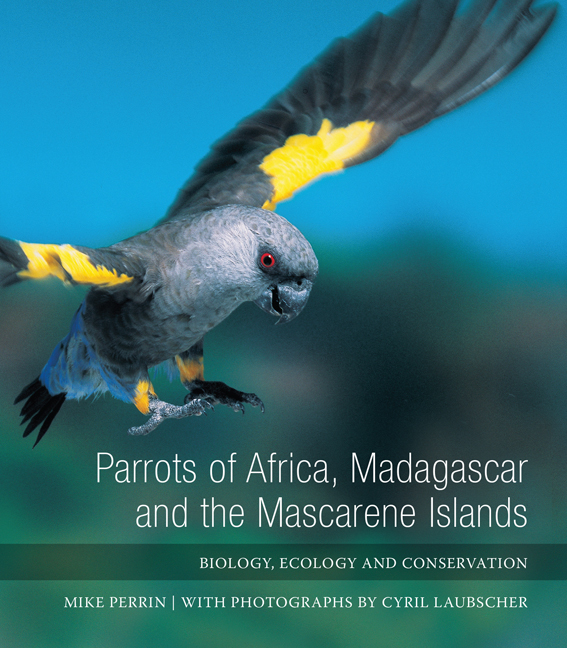Book contents
- Frontmatter
- Contents at a glance
- Contents
- Acknowledgements
- List of tables
- List of figures
- Abbreviations
- Chapter 1 Introduction
- Chapter 2 Conservation Biology
- Chapter 3 Systematics
- Chapter 4 Biogeography and Niche Separation
- Chapter 5 Intelligence, Communication and Behaviour
- Chapter 6 Breeding Biology
- Chapter 7 Diet and Metabolism
- Chapter 8 Case Study – The Cape Parrot
- Chapter 9 Trade in African parrots
- Chapter 10 African Parrot Conservation
- THE PARROT SPECIES OF AFRICA
- IUCN CATEGORIES
- Chapter 11 Long-Tailed and Fossil Parrots
- Chapter 12 True Parrots
- Chapter 13 Lovebirds
- Chapter 14 Field Techniques in Parrot Research
- Species lists
- Glossary
- Bibliography
- Index
Chapter 6 - Breeding Biology
Published online by Cambridge University Press: 04 June 2019
- Frontmatter
- Contents at a glance
- Contents
- Acknowledgements
- List of tables
- List of figures
- Abbreviations
- Chapter 1 Introduction
- Chapter 2 Conservation Biology
- Chapter 3 Systematics
- Chapter 4 Biogeography and Niche Separation
- Chapter 5 Intelligence, Communication and Behaviour
- Chapter 6 Breeding Biology
- Chapter 7 Diet and Metabolism
- Chapter 8 Case Study – The Cape Parrot
- Chapter 9 Trade in African parrots
- Chapter 10 African Parrot Conservation
- THE PARROT SPECIES OF AFRICA
- IUCN CATEGORIES
- Chapter 11 Long-Tailed and Fossil Parrots
- Chapter 12 True Parrots
- Chapter 13 Lovebirds
- Chapter 14 Field Techniques in Parrot Research
- Species lists
- Glossary
- Bibliography
- Index
Summary
Parrots are generally monogamous and at least the larger species pair for life. The pair bond is constantly reinforced by allopreening and courtship feeding. Usually, compatible pairs having experience of one another breed more successfully than inexperienced pairs. Most parrot species show no sexual dimorphism although this is not uncommon in several African species. Gender differences are usually in the plumage although there may be small differences in body size and bill structure.
Possession of the nest cavity is the first component of the breeding cycle that causes fighting between conspecifics. The nest cavity is the focus of an extraordinary amount of attention by a pair long before egg-laying begins.
Whilst breeding, African parrots are territorial and defend at least a small area around their nest (Juniper & Parr 1998). Species living outside the tropics, where food availability is seasonal, have more clearly defined breeding seasons. In arid zones, rainfall is the proximate factor cueing the initiation of reproduction. The parrots’ mainly monogamous breeding system, the established pair bond, and the ability to commence nesting at any time that conditions become suitable, all facilitate opportunistic breeding, but this is uncommon in African species.
There may be a link between the onset of egg-laying and incubation behaviour and the daytime darkness experienced by parrots spending time in their nest hollows. Endocrine changes are an important component of the breeding cycle. Females spend an increasing amount of time in the nest cavity prior to egg-laying and in most species, the female alone incubates. Male birds feed the incubating females.
In courtship, several variations occur in the approach behaviour of different parrots, involving, for example, head bobbing, head stretching and tail fanning. For many parrots, allopreening and allofeeding are the key behavioural mechanisms for year-round pair-bond maintenance.
The nest preparation may take several weeks if, for example, the entrance needs widening or the base levelling. In some species, the female works alone in an existing cavity, kicking out detritus from the bottom of the cavity while the male perches nearby. Often, the pair retains a nest site year to year; this usually occurs when breeding has been successful. In such cases, the time spent in nest preparation diminishes and may become ritualised.
- Type
- Chapter
- Information
- Parrots of Africa, Madagascar and the Mascarene IslandsBiology, Ecology and Conservation, pp. 129 - 158Publisher: Wits University PressPrint publication year: 2012



